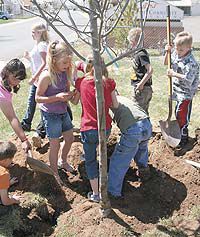| Citizens plant a tree in East Carbon during April’s Arbor Day celebration. |
Whether doing it to be more environmentally conscious or to make your home’s landscape more aesthetically appealing, planting a tree or trees around your property can be a great way to spend some time outdoors while making a positive impact on your surroundings. But before heading to your local nursery or out to the yard with your shovel, there are some things to consider when it comes to planting trees around your property.
What type of tree?
Do you want to plant an evergreen or a deciduous tree? Each tree comes with its own benefits. Evergreens won’t shed their leaves in the colder months, meaning they’ll provide shade year-round. These trees can also be very functional for those who live in areas with particularly harsh winters, as evergreens remain thick in the winter, making them a good choice for homeowners who want their trees to function as barriers from wind or noise.
Deciduous trees provide functionality as well, but on the opposite end of the spectrum. Deciduous trees can provide shade in the summertime and allow sunlight to come through in the wintertime once they’ve shed their leaves. For homeowners with young children who love to play in the yard, deciduous trees can protect kids from getting too hot in the warmer months and too cold during winter.
Where to plant your new tree?
Where to plant your tree should be of the utmost importance. This involves knowing what the tree will look like down the road. You won’t want to plant a tree that will get very big too close to your home, as a storm or other inclement weather could result in the tree potentially damaging the house. Even if that does not happen, you want to avoid having the tree removed when it reaches maturity. If you feel it’s gotten too big and you do want it removed to avoid an accident, this can be a costly expense.
Another thing to consider is property lines. If the tree crosses the property line when it reaches maturity, it could cause trouble for you with your neighbors. Also, you don’t want the tree to be in a position where it’s impeding sunlight from reaching a neighbor’s home in winter (or your own home for that matter).
Before deciding on where to plant your tree, know how big it is likely to get, and make sure you don’t plant it too close to your property line, especially if it will be very large once it reaches maturity.
What is the tree history? Most local nurseries won’t sell trees that have proven problematic to residents of the area in the past. Some trees carry with them a susceptibility to certain disease or insect infestations, while others are known for having weak wood that won’t stand up well in areas where wind is a staple of the weather.
Be sure that the nursery you choose only sells trees that have a proven track record of success in your area. While it’s a nice idea to have an exotic tree in your yard, it’s not nice to have to pay to treat such trees when they can’t handle the local weather or insect population.
What will the tree look like?
Looks are important, as no one wants to plant an eyesore in their front yard. Trees can be wonderful additions to a landscape by complementing surrounding flowers or shrubs and even the color of your home. Ask a local nursery professional what a specific tree will look like throughout the seasons.

